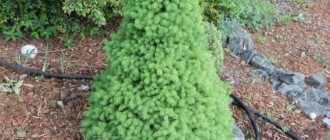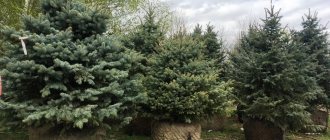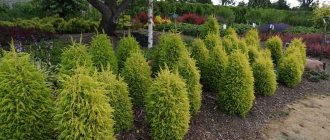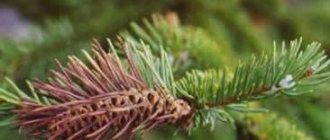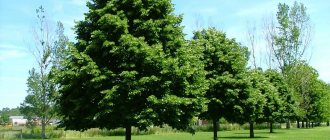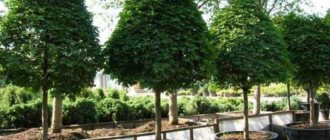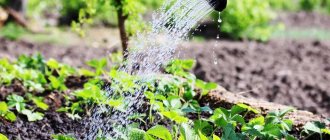Conifers are a large group of resinous, cone-bearing trees and shrubs. According to biological classification, conifers form the order Coniferales, a group of gymnosperms whose seeds do not produce color. There are 7 families of conifers, which are divided into 67 groups called genera, which are divided into more than 600 species.
Coniferous trees have cones, and their leaves do not fall all year round. However, some, such as the yew, have a fleshy and fruit-like cone. Other plants, such as cypress and juniper, produce cones that resemble berries rather than what is considered a "cone."
Origin of conifers
Conifers or pinopsids are the oldest group of gymnosperms. Their first representatives grew in the northern latitudes of the planet 370 million years ago. This was the age of dinosaurs, the late Carboniferous period of the Paleozoic era. Later, it was these representatives of the flora that played the main role in increasing the cover of vegetation in the northern hemisphere.
Around 185-66 million years ago, pinopsids occupied large areas and were highly diverse. This period can be considered the starting point for modern conifers.
Approximately 66-2.5 million years ago, the oldest species could be found everywhere, including Antarctica and Greenland, beyond the tree line.
Interesting fact : conifers hold the following plant world records. The maximum height is evergreen sequoia (115.2 m), crown thickness is Mexican taxodium (11.42 m in diameter), age is long-lived pine (4700 years).
Siberian spruce
In Russia it grows in Siberia, the Urals and the Far East. This species requires high humidity and nutritious soil for normal life.
You also need to be careful in caring for it, as it is often attacked by various insects.
Description
The vast majority of conifers are perennials and evergreens. Only a few of them shed their needles for the winter. The rest renew their needles gradually, every few years.
Features of conifers:
- leaves are modified into needles;
- wood and bark contain many resinous substances;
- in the wild they grow up to 100 m or more;
- the formation of seeds covered with scales occurs in cones;
- Most of them are long-lived.
Root
The roots of the Siberian cedar pine
Conifers have a branched root system consisting of a long primary (tap) root with shoots in different directions and multiple short, branched roots. The latter are absorbent organs. Evergreen trees develop a taproot to great depths; it lies deep in the ground, up to two meters, which allows the species to survive in conditions of prolonged drought.
Foliage
Conifer needles
Conifers have a predominant needle shape. There are breeds with wide leaves in the form of stripes or scales. Their arrangement on the branch is mostly spiral-shaped, rarely opposite. They stretch from 2 mm to 400 mm in length. Trees growing in low light have darker needles. In blue spruce they have a matte-waxy coating, which protects the tree from ultraviolet radiation. Modified leaves retain moisture well and do not allow it to evaporate during drought, allowing sunlight to penetrate and absorb heat.
Reproduction
Pine cones
Coniferous trees mainly reproduce by seeds. Their difference from angiosperms is the absence of flowers and inflorescences, pistils and stamens. In spring, two types of cones are formed on the branches of the tree: male cones are microstrobiles, female cones are megastrobiles.
The cone consists of an axis and scales attached to it. On each cell of the megastrobilus, located at the top of the branches, two ovules with eggs inside ripen. Pollen ripens in greenish-yellow microstrobili. Then, with the help of the wind, animals or birds, it is transferred to the megastrobiles. The cone is glued together with resin, and the process of seed ripening begins. Two years later she falls to the ground. The seeds scatter on the ground and begin to germinate.
Japanese Pieris (Pieris japonica)
An ornamental shrub that is attractive all year round. In late summer, reddish buds appear for next year's blooms. During the winter months, these beady buds contrast with the evergreen, glossy foliage.
Pieris japonica is an early blooming flower; it blooms for about two weeks in late winter - early spring. The white or pink flowers resemble lily of the valley flowers, but without the strong scent.
Warning—the leaves, flowers, and by-products (honey) of this shrub are highly toxic to humans and pets. Like rhododendron, it contains serotoxins, which if ingested can be fatal. For this reason, Pieris japonica is not recommended if children are playing in the yard or pets are wandering around.
These shrubs prefer shady places where they will be protected from drying winds, and like to take root in acidic soil.
Well-draining soil is preferred to prevent dangerous fungal infections, and this species is susceptible to the same diseases as azaleas.
Fungal diseases mainly spread in humid weather. Therefore, proper spacing between bushes is critical for good air circulation and plant health. Shrubs should be placed at a distance of about 180-210 cm from each other, taking into account their size in adulthood.
Pieris japonica prefers full sun rather than partial shade. In warmer climates, it should be planted in a location where it is protected from the hot afternoon sun.
The soil should be rich in organic matter and moist but well-drained; This shrub does not grow well in wet soils.
Pieris japonica is an acid-loving plant that does not tolerate alkaline soils. Before planting, you should check the soil pH and add a special fertilizer for azaleas, camellias and rhododendrons that contains sulfur to raise the pH level.
In the absence of rain, the shrub needs regular deep watering about once a week. It is necessary to moisten the soil to a depth of 8 cm.
A layer of pine needle mulch about 5-8 cm thick helps retain moisture in the soil.
Where do they grow?
Map of the distribution of pine trees
Evergreen species can be found on all continents of the planet:
- from the Equator, right up to the boundaries of permafrost;
- on the Eurasian continent;
- in Central and South America;
- some species are endemic to Africa and the tropics.
Coniferous forests grow best where winters are long and the climate is cold, with average to high annual rainfall. Moist soil is necessary for their life. Some representatives are found even beyond the Arctic Circle. In warm latitudes, these trees predominate in mountainous areas where there is no intense heat.
For the most part, pinopsids grow along the Pacific Ocean. Scientists believe that after the Mesozoic era, when these plants reached their highest development, the climate in these areas changed very little.
Interesting fact : scientists consider extinct fern-like ancestors of gymnosperms, and their first representatives date back to the late Devonian period.
Spruce
The number of subspecies is enormous, you can find it in the photo catalog of plants. In Russia, spruce is one of the most beloved coniferous trees.
It tolerates shadow quite well, but loves light more.
When constructing sanatoriums and other health institutions, it is necessary to plant fir trees there - to create a cozy atmosphere and further purify the air with the substances they emit.
In addition to being used in the landscape, wood is used to make musical instruments, paper, artificial silk and much more.
Types of coniferous trees
Types of coniferous trees
Types of coniferous trees
Types of coniferous trees
Types of coniferous trees
Conifers differ in size, crown shape, color and configuration of needles and cones. Among them there are towering giants and compact small trees.
Main types of conifers:
- Pinaceae are the most common family of conifers. Some of its representatives climb mountains, others grow beyond the Arctic Circle and even enter the Southern Hemisphere.
- Cypress trees grow in the wild along the edges of rivers and in coastal areas. They tolerate drought and short-term temperature drops to -20 degrees. They are unpretentious in the choice of soil: they can live in calcareous, rocky, and slightly salty soil.
- The yew family, which grows more often in areas with mild temperate or subtropical climates, has 6 genera and more than 30 species.
- Araucarias have three genera and 40 species. A characteristic feature is the fusion of the seed and covering scales and the presence of one ovule.
Yew (Taxus)
Yews are coniferous trees, so instead of flowers they produce cones (along with red berries). They are characterized by evergreen needles and a wide range of sizes and shapes, as well as a fairly rapid growth rate that slows down as the plant matures. It is best to plant them in spring or fall.
Soil type and PH – well-drained loam of medium moisture, neutral.
Pine
The largest genera of the family are fir, larch, spruce and pine. Among them there are both evergreen and deciduous plants.
Dwarf
Gnome
This is a small Mediterranean pine tree in the shape of a ball. Thick green needles grow in the form of sharp needles that grow from resinous buds. Oval dark brown cones look like vertical candles. The plants are hardy, not afraid of frost, but do not like drought.
Pug
Pug
This tree, similar to an ellipse, grows almost equally in height and breadth. Resistant to frost and wind, content with a small amount of water. The pug grows slowly, reaching one and a half meters in height, adding 2-4 cm per year. It is not very picky about the soil and reacts poorly to air pollution. Changes needles once every 3-5 years.
Interesting: How and why do trees survive in winter? Reasons, photos and videos
Ophir
Ophir
is a dwarf tree whose trunk reaches a height of 50 cm. It has a good ability to grow in breadth. The crown of the ophir resembles a pillow in shape, but over time it becomes like a cone, expanding from below. The shrub's needles are hard and sharp, arranged in bunches, 3 cm long. Their color changes depending on the time of year: from bright green in summer to yellow in autumn. Ophir is unpretentious, resistant to frost and irregular watering. Exudes a special aroma caused by the release of essential oils.
yellow pine
Yellow pine
Yellow pine is also called Oregon pine due to its widespread habitat - rocky mountains 1400-2600 m high, located in Oregon (North America). The needles and bark may be yellow, brown or reddish in color. Oregon pine is distinguished by its ability to prevent the spread of forest fires. Pine can grow up to 80 m, while the width of its crown can be up to 8 m.
Cedar pine
Cedar pine
This type of pine is called the king of the taiga zone. Under favorable conditions, a tree can survive up to 800 years. It grows up to 45 m in height, and the diameter of the cedar pine trunk can be two meters. In young breeds, the trunk is thin and the crown resembles a pyramid; in adults, the trunk is strong and has branches scattered on the sides. The tree is famous for its lush dark green needles with a blue tint and soft needles. The distribution zone of Siberian cedar is the Northern Urals, Siberia and the Far East.
Interesting fact : the growing season of cedar pine is only one and a half months a year. The rest of the period the tree remains dormant, which is why it lives to such an old age.
Whitebark pine
Whitebark pine
A frost-resistant and light-loving conifer (another name is “Geldreich’s pine”) has a small height (3-3.5 m) and diameter (2 m). The cone-shaped crown is made up of dense branches with hard, shiny needles. The pine tree is distinguished by a powerful, well-branched root that grows deep into the ground.
Interesting fact : the oldest representative of the whitebark pine species grows in Bulgaria. The ancient record holder is already 1300 years old.
Weymouth pine (American)
Weymouth pine (American)
The famous English explorer Weymouth at the beginning of the 18th century brought pine from America to Europe, which is now named after him. The second name of the tree is white. In North America, the habitat of this conifer is moist loamy and sandy soils, but sometimes it climbs high into the mountains. There, at an altitude of 1.5 thousand meters, a British officer discovered the tree.
In nature, these specimens live up to 400 years. Capable of growing up to 70 m, having a diameter of up to 1.8 m. The tree trunk is well branched, the crown has the shape of a cone.
Edel
Edel
A small shrub in the shape of a ball, over the years it takes on the appearance of a pillow and grows very slowly. In adulthood, it has a height of 0.8-1 m. It has silver-green needles with thin and delicate needles that make up individual bunches. Young plants already have cones. Edel does not like either dry or overly wet and saline soil. Withstands severe frosts well, prefers partial shade, does not like heat. It is not uncommon for it to be burned by spring sun rays. Edel's homeland is North America, where the breed can grow up to 60-70 m. The crown takes the shape of a pyramid. Among pine trees, one of the fastest growing plants.
Oil pine
Butter Pine
The Weymouth Butter Pine is amazingly beautiful and has the shape of a ball. Its silvery-green needles consist of so-called “little curls” - curved needles. This makes the plant seem thick and fluffy. Tiny Curls are a dwarf variety of Weymouth, growing to approximately 100cm in height.
Norway spruce
Common
spruce Coniferous forests stretch all the way to the Urals, where common spruce grows very abundantly. Its homeland is Europe. This plant is 20-30 m tall, the trunk is 1 m in diameter, and the cone-shaped crown, which remains sharp until the end of its life, is 6-10 m. The gray layered bark is usually covered with deep cracks. The short dark needles are hard and sharp; the cones, which ripen in winter, are up to 15-17 cm long; in young breeds they have a purple tint, then turn brown. Spruce trees live from 200 to 400 years both in the mountains and in marshy soils.
Siberian spruce
Siberian spruce
A tall (up to 20-30m) tree with a straight, pyramid-shaped trunk, it lives in Western and Eastern Siberia, where frosts below -45 degrees are not uncommon. Easily withstands very low temperatures. The gray bark is covered with cracks. Depending on the subtypes, the needles may have green, bluish-blue, silver or golden color. Cones in the form of a cylinder or oval, brown in color. Often forms hybrids with common spruce.
Serbian spruce
Serbian spruce
This endemic species of spruce was discovered by the Serbian scientist Pancic (its second name is “Pancic spruce”) in the second half of the 19th century. The tree grows in a small area of 60 hectares in the Drina River valley. It stretches upward very quickly, reaching a height of up to 40 m. The brown-violet cones look elegant against the background of the bluish-green crown. They are 4-7 cm long and resemble a spindle. After ripening they acquire a dark brown color.
Silver spruce
Silver spruce
A very slender, beautiful and unpretentious plant with a spire-like crown, in the wild it grows both in small groups and alone. It is resistant to frost, polluted air, and snowdrifts. Silver spruce chooses places along rivers, the northern slopes of mountains, and is found at an altitude of 2000-3000 m above sea level. The tree grows up to 50 m, developing a crown up to a meter in diameter.
The sharp but not hard needles have 4 sides and grow in different directions. Its color is bluish-green, there are two silver stripes on the bottom and top of the needles (hence the name). The lower branches lie on the ground, and yellow and purple-brown seed cones hang from the upper branches. The bark is covered with gray scales.
Interesting: Is it true that there is less oxygen in the air in winter?
Fir
Fir
Tall cone-shaped firs, reminiscent of spruce in appearance, do not like severe frosts, high temperatures and lack of moisture. They are light-loving, but can also grow in shaded areas. In the wild they live for a very long time - up to 400-700 years. The column-shaped trunk is covered with a dense crown, which over the years takes on the shape of a cylinder. Fir sheds its needles every 8-10 years. In the fourth decade, the tree begins to bear its first fruits.
Caucasian Nordmann fir
Caucasian Nordmann fir
This type of conifer often decorates New Year's holidays in homes and city squares. It is popular for parks and gardens as an ornamental tree, although it grows at a slow pace. The Caucasian beauty rushes up to 60 m (sometimes up to 70-80 m), having a trunk diameter of up to 2 m. It is one of the tallest trees in Europe.
Silver fir
Silver fir
High in the mountains of North America, along the Pacific coast, lives the slender, cone-shaped silver fir (another name is “noble”). Being young, it grows slowly, but the trunk of an adult tree begins to quickly stretch and can reach 80 m in height with a diameter of 2 m 20 cm. It loves moisture and warmth, but is not resistant to frost.
Its wood is durable and in great demand. Cones - microstrobiles occupy the lower part of the tree, while megastrobiles are located on the uppermost branches.
Korean fir
Korean fir
Even in summer, it seems that the branches of this pine species are covered with white snow. This is because the inside of the needles is covered with silvery veins, which are visible due to the curved ends of the needles. Fir lives in coniferous and mixed forests, on mountain slopes. The plant is distinguished by the fact that it grows in breadth, while it is in no hurry to stretch upward. In young species the bark is light and smooth, but with age it darkens and cracks. Blue cones up to 7-8 cm in length, cylindrical in shape and with a purple tint. They look elegant on the emerald-silver lush crown.
Balsam fir
Balsam fir
grows well in shaded areas, but also loves the sun and good lighting. Prefers moisture and good soil and grows up to 25 m in height. The crown resembles a regular cone, the branches grow all the way to the ground. The needles are not hard, with a special shine, the ends of the needles are blunt. The tree exudes a special aroma of resin. Shallow roots are concentrated near the surface of the earth. Due to this, the tree is not wind-resistant. It grows in areas with cool climates and lives a long time (up to 300 years).
Larch
Larch
Unlike other coniferous species, this tree sheds its leaves in the fall and, remaining in a dress of graceful round cones, feels great in winter frosts. The larch trunk is thicker than that of its closest relatives, almost a meter in diameter. The crown of a young larch is cone-shaped, in adulthood it becomes similar to the shape of an egg. Under favorable conditions, it lives a long time, from 300 to 800 years. Does not tolerate shadows. The habitat is Western and Northern Europe, the Carpathians.
Interesting fact : such architectural landmarks of St. Petersburg as the Winter Palace and St. Isaac's Cathedral were built on piles of high-strength larch.
Hemlock
Hemlock
Carl Linnaeus classified the hemlock coniferous tree, native to eastern North America, in the 18th century. It thrives in the shade and loves moisture and acidified soil. It is a 30-meter tall cone-shaped plant with reddish scaly bark. Male cones are yellow and female cones are light green. Paper and furniture are made from this rock.
Ketelery
Keteleeria
Some species of Keteleeria live in the wild for up to 1200 years. The habitat of these trees is considered to be China and the island of Taiwan. The plant is named after the Belgian gardener Keteleer, who isolated it only in the second half of the 19th century. This is a monoecious plant, the microstrobiles are covered with needles at the ends, the megastrobiles have axils. The ovoid cones ripen in December. Whorled branches of trees are located on the trunk at different distances from each other.
Douglas fir (Pseudotsuga menziesii)
This tall coniferous tree can reach a height of 120 cm to 90 meters, but there are smaller varieties available for the home landscape. As it grows, the Douglas fir takes on a pyramidal shape.
Douglas fir does not like hot and dry winds, but thrives in moist soil and humid climates. However, wherever you plant it, it should have full sun.
The ideal soil for this tree is acidic loam with drainage.
It is best not to trim a fir unless it needs to be trimmed from damaged, diseased or dead branches.
Evergreen shrubs enliven dull winter landscapes with their lush greenery. Some spring-blooming specimens produce colorful berries in the fall, making them attractive year-round.
Vertical gardening - from idea to implementation, choosing options according to budget and attractiveness (photo + video)- Vertical flower beds - basic principles and rules for choosing plants and arranging a suburban area with your own hands
Decorative grass - 140 photos of original design. Review of the best varieties of grass for the garden, instructions, reviews, videos + gardener recommendations
However, most of the evergreen shrubs featured here are prized for their resilient foliage and ability to bloom in cold climates, where the display of their winter greenery is most welcome.
What is an evergreen shrub?
It has the following features:
- less than 450 cm in height;
- several stems growing from the same point in the ground;
- responds well to pruning and care;
- has year-round foliage.
Cypress
The cypress family includes several dozen species of heat-loving evergreens. Being ancient relict species, they prefer tropical and subtropical climates to live.
Thuja
Thuja
This tree is also called the Life Tree. Thuja can grow up to 70 m in height and up to 6 m in width. The needles of young trees are soft and become scaly over the years. The shape of the crown varies among different species: spherical, rectangular, pear-shaped, creeping, horizontal.
Thuja bears fruit annually and produces a rich harvest every 2-3 years. This is a monoecious plant, the cones are oval or oblong, covered with 2-6 pairs of scales.
Juniper polycarp
Juniper prolifica
A squat shrub with a dense reddish or red-gray crown. Short branches with black and blue fruits. The dioecious plant lives up to 200 years. Situated in groups or alone. Tolerates drought and rocky soil well. This species is widespread in Central Asia, Pakistan, and Afghanistan.
Cryptomeria
Cryptomeria
Other names are “Japanese cedar” (not actually a cedar), “sugu” and “shan”, the only representative of the genus Cryptomeria in the cypress family. It grows in Japan and China in areas with a warm and humid climate. It has a straight cylindrical trunk up to 2 m in diameter and a beautiful pyramidal crown. The needles are light green in color and are arranged in a spiral on the branch. The wood is light and practically not subject to rotting.
Red cedar
Virgin Juniper
A coniferous species native to North America has the international name Juniperus virginiana. It has a powerful root system with numerous branches. The needles are scaly, with a specific smell. Juniper grows quickly and loves bright places. The shrub has low soil requirements and is resistant to wind and rot. In the natural environment it can live up to 500 years.
Juniper squamosus
Scaly juniper
The species' range includes the mountainous regions of China, Taiwan, and the Eastern Himalayas. A frost-resistant and light-loving plant, it is a shrub with dense branches and needles, 0.5-0.8 cm long. The crown is dome-shaped. Black shiny fruits - cones ripen the next year. Growth is up to 1.3-1.5 m in height. Not afraid of drought and rot. It takes root well on any soil.
Cypress evergreen
Evergreen cypress A
woody plant 25-30 m in height with dark green soft needles, grows in Europe and Asia, in the Crimea and the Caucasus. Small round cones are covered with scales that look like patterns. The tree grows quickly, on almost any soil, is resistant to drought, is not afraid of shade and a short drop in temperature to -20 degrees. The genus of cypress trees belongs to ancient plants, some of them can live up to 2000-3000 years.
Interesting fact : insects are repelled by the specific smell of cypress, so they are not found where it is present. By placing a cypress branch in a closet with clothes, you can get rid of moths.
Cypress
Cypress
Translated from Greek, cypress means “cypress on the ground.” This monoecious coniferous plant is a cross between cypress and thuja. Young representatives have needles in the form of needles, while older ones have scaly ones. Woody cones grow at the ends of the branches, smaller in size than those of cypress. The tree can grow up to 70 m.
Interesting: Steppe - Description, features, types, location, soils, climate, flora, fauna, photos and videos
Kallitris
Callitris
This is a tree with scaly needles arranged in rows of three. The height of the plants is from 5 to 25 m. They resemble a ball or an egg in shape. At the ends of the branches, ovoid or round cones of different sexes appear: male, small, 3-6 mm, and female, larger, up to 1-3 cm in length and width. They take about a year and a half to mature. They can remain closed for a very long time until there is a fire in the forest. The cones open, and the seeds scatter on the scorched earth and germinate.
Evergreen boxwood (Buxus sempervires)
The genus Buxus includes about 70 species of slow-growing, broad-leaved evergreens. Most garden forms are cultivars or hybrids of two species: B. sempervirens and B. microphylla.
Boxwoods are typically large shrubs or small trees, but most varieties used in modern landscaping are dwarf varieties such as B. Sempervirens 'Suffruticosa' and Buxus sinica var. Insularis.
Reaching a mature height of just 60cm, these dwarf boxwood shrubs are prized for their thick, light green leaves and round, compact shape when growing.
Boxwood is best planted in loamy soil in full sun or partial shade, preferably in an area better protected from the wind. Their roots are shallow, so the soil must be protected from heat.
There should be an 8cm thick layer of organic garden mulch around each plant. The mulch should be 5cm from the trunk and about 30cm outwards around the entire circumference if space allows. If this process is carried out close to a bush or tree, pests can be attracted.
Boxwood tolerates full sun to partial shade, but is preferably planted in dappled shade during the hottest part of the day. Covered by trees, dwarf boxwood roots will benefit from cooler soil temperatures.
Boxwood bushes require well-drained soil or they will suffer from root rot. Although they can tolerate soils with lower pH, a soil pH in the range of 6.8 to 7.5 is preferred.
For the first two years, boxwood requires weekly deep watering, otherwise the moisture will not reach the main root system. With deep watering every 2-4 weeks, mature plants will grow well.
In the spring, before new shoots appear, the bushes must be fertilized with universal fertilizer.
Yew
The leaves of this species are hard, linear or lanceolate, with narrow or wide needles. For the most part, trees remain green all year round, but there are, although very rarely, species that lose leaves in winter.
Interesting fact : yew needles are dangerous for animals, as they cause poisoning.
Yew berry
Yew berry
A very elegant evergreen plant, sometimes reaching 40 m in height, has healing properties. At the same time, it is poisonous. It grows slowly, but its life expectancy is high - several thousand years. A lush, dense bush in shape resembles a cylinder or pyramid. The bark is smooth, red-gray. Flat dark green needles 20-35 mm long are arranged in a spiral. The strong branched root allows the yew to grow in any type of soil. It reproduces by seeds, which are spread by birds eating the berries of the bush.
Torreya
Torrey
The genus of the yew family is named after the American flora researcher John Torrey. It is a small tree, usually 5-20 m in height. The spiral-shaped needles are rigid, with pointed ends. The plant can be either monoecious or dioecious. Female cones mature in a year and a half. The only large seed looks like a nut.
The needles, stems, and cones emit a very unpleasant aroma. The range of torrea is East Asia and North America.
Leucothoe
It is a hardy and disease-resistant shrub that requires minimal special care.
The leaves have a leathery texture and their dark green color turns to shades of purple and bronze in the fall. Creamy white bell-shaped flowers add interest to this beautiful shrub, ideal for shady gardens.
The flowers are slightly fragrant, with a slight honey-like scent that attracts pollinators such as butterflies and bees, making this plant desirable and attractive in the garden landscape.
Overall, this evergreen has a pleasing array of seasonal garb, from young, bright green leaves in early spring to white flowers tinged with pink in late spring and early summer, to its autumn transition to deeper bronze and purple flowers.
Watering the site - types and types of systems, main differences and features, rules for selection and installation, as well as recommendations for operationOrnamental plants - 140 photo options. Review of the most popular plants with names and descriptions. Gardener's recommendations + reviews
Boxwood: planting, care, growing in open ground, propagation. Full description of the plant from A to Z. More than 100 photos of evergreen shrubs
Prefers medium, slightly acidic and well-drained soil.
Araucariaceae
Araucariaceae are tall trees of the Southern Hemisphere. These ancient plants were widespread throughout the planet during the Jurassic and Cretaceous periods. Later they left the territories of the Northern Hemisphere.
Agathis
Agathis
In New Zealand, a large (up to 80 m) coniferous plant grows, with lush, spreading branches, large round cones (15 cm in diameter) and soft long (up to 18 cm) leaves. The tree has elastic, high-quality wood, which is very valuable when processing. The gray-brown bark is smooth, almost without knots. The branches grow horizontally, eventually hanging down. Fresh ovate orange leaves look very nice with old green elliptical foliage.
Araucaria
Araucaria
Araucaria gets its name from the province of Arauco, located in Chile. These flat-coniferous giants with hard, needle-like leaves have a strong, straight trunk up to 30-80 m high. Being dioecious, the plants are able to change sex throughout their lives. Female (round) cones, which grow in the upper part of the crown, and male (elongated) cones up to 20 cm long, weigh up to 1.5 kg. The seeds can be eaten.
Araucarias mostly grow in Australia, New Guinea, two species are found in America. The plant is grown as an ornamental in the Crimea and the Caucasus.
Sequoia
Sequoia
One of the largest trees in the world, reaching 60-100 m in height. Redwoods have existed since the age of dinosaurs. They are about 200 million years old. A special feature is that when there is a lack of moisture, they shed entire branches instead of needles. In very ancient times they grew abundantly in the northern hemisphere, but now there are only three species, and they are present in America and China. Their large trunk, tapering upward, has a diameter of 3-4.5 m. The bark is thick, hard, red-brown in color. Male cones in the shape of a ball or egg have a size of 2-5 mm, and female cones in the shape of an ellipse - 12-35 mm.
Arizona cypress (Cupressus arizonica)
The tiny leaves look like scales and come in different shades of green on different varieties, including gray-green and blue-green.
The trees thrive in full sun and well-drained soil, as well as in hot, dry conditions. It grows at a moderate pace, adding from 30 to 60 cm per year and reaches a height of up to one and a half meters.
Cupressus arizonica requires a location that provides sufficient direct sunlight.
Can grow in acidic, neutral or alkaline soil. They tolerate clay, loam or sandy soils well, but they must be well drained. It will grow better if it is watered regularly, or better yet, irrigated.
What coniferous trees are bought for the New Year?
Spruce is an indispensable attribute of the New Year's holiday.
New Year's holidays cannot be imagined without fragrant spruce, pine or fir. They decorate apartments with their presence and look great under the snow caps in large parks and squares.
Some people prefer spruce because of its low price and fragrant resin aroma. The cone-shaped crown of a tree with thick branches looks bright and festive when dressed up.
In a warm room, spruce quickly loses its fresh appearance and smell. The needles quickly begin to dry out and turn yellow. To somehow refresh the plant, you need to constantly spray and water it.
Pine is considered more resistant to home heat, but its price is higher. But for those who are attracted by the rich antimicrobial aroma, this conifer is just right. Pine is not as thick as spruce, but its needles are long and strong, so you can hang toys on them without fear. Its negative side is the release of sticky, difficult to wash off resin.
Fir will last the longest without losing its freshness. Due to the soft, non-thorny needles, dressing it up is a pleasure. The downside is the lack of pine smell and the high price.
When is the best time to prune evergreen bushes?
As a rule, needle bushes are pruned in early spring - towards the end of the dormant period and before new shoots appear. Pruning plants at this time allows enough time for new shoots to appear and also allows them to get stronger until next winter.
But often broadleaf shrubs (and some needle-bearing varieties) require a different approach. For example, if they are flowering shrubs (that is, plants valued for their flowers), you will have to wait until after the flowering period to prune them. Otherwise, the more flower buds that are removed during the pruning process, the less pleasure will be obtained from the sight of flowering plants.
And what’s the point of growing such a bush if you can’t admire its flowers? In particular, pruning azaleas and rhododendrons after they have finished flowering makes much more sense than pre-pruning them.
Mr. Summer resident informs
Having decided to plant coniferous trees and bushes at your dacha, you carefully select seedlings. To purchase, contact only specialized nurseries located nearby. This guarantees good survival of the plant and its adaptability to local climatic conditions. Purchasing planting material in wide-ranging shopping centers means risking the money spent. In most cases, plants are planted in low-quality substrate, overfed with fertilizers and hormones, and will have to be nursed for a long time, possibly without success. Moreover, you should not buy conifers from random sellers on the market. Along with the seedling, diseases and pests can be brought to the site.
In order for the garden composition to bring joy, we carefully study the rules of planting and growing each species or variety.
Thuja
This needle-shaped plant is basic in a landscaping project; it can be safely used both for the city (since it tolerates polluted air well) and for the country house.
There are quite a few varieties, we list what they are:
- Eastern
- Western
- Folded
- Korean
Thujas are used in landscape design as hedges or other decorative compositions. They can be short and huge (for example, Folded). The fruits are small oval-shaped cones.
Redwoods
The tallest and oldest tree on the planet, the sequoia, grows wild only in California (USA). The branches of the conical crown are located strictly horizontally, only occasionally bending slightly downwards, the average life expectancy is about one and a half thousand years.
The tree is not grown in open ground at our latitudes; it needs a lot of moisture in the ground and air. Indoor bonsai-style options are more popular. They require a lot of patience and care, but the exquisite beauty of the composition makes up for all the difficulties.
Cedar
One of the most aristocratic trees. If you plant cedar trees at the entrance to the house, a solemn atmosphere is immediately created, they give a finished look to the entire design, add strength and elation to the appearance of the estate.
An undoubted advantage is that there is no need for constant care, no need to trim, shape the crown, or remove fallen leaves in the autumn season. And the unique aroma of nearby plantings heals the air.
It is not for nothing that they are included in the list of unique trees of the Kirov region. All cedar trees have a very interesting structure.
Just like other representatives, cedars are long-livers, their average life span is 800-1000 years. They are very common in Siberia, but also grow in the southern part of Russia, in Sochi and the Krasnodar Territory.
The article presents only a few coniferous trees, photos and names, of course there are many more of them, but within the framework of one material, it is simply impossible to describe everything.
Therefore, if you are puzzled by the design of a garden plot or a design project, then feel free to take note of plants from the coniferous class, because their use will decorate any area.


